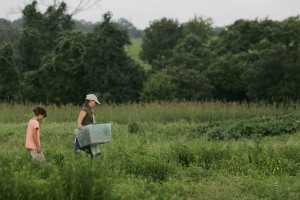Texas Proposition 1: Right to Farm or Right to Harm?
Texas needs to address abuses by local governments that are harming farmers and reducing our ability to raise healthy food without giving agricultural operations a blank check to be bad neighbors. We can raise food in ways that don’t harm public health and safety, and it’s in all our best interests to do so.
In November, Texans will vote on a proposed constitutional amendment, HJR 126, that would enshrine the "right to farm" in the Texas constitution.
Farm and Ranch Freedom Alliance (FARFA) opposes this amendment. While it sounds good and it will help some farmers who are struggling with unfair government regulations, the amendment goes much too far and will end up hurting both farmers and communities.
"Right to Farm" is one of the trickiest issues we deal with because small farmers and ranchers all too often face unreasonable regulations and actions from government at all levels. Local governments in particular often weaponize zoning laws to drive out small farms because they don’t think agriculture belongs in their cities or towns. The testimony in support of HJR 126 included examples of blatantly unreasonable and punitive regulations that are in place right now.
FARFA fully supports reining in cities’ overregulation of farms based on aesthetics and unfounded biases. Farmers and ranchers have the right to use their land to raise food, for themselves and for sale. And it’s not only their right - it benefits us all.
The problem is that big agribusiness uses this legitimate issue to push overreaching laws that are more properly labeled "right to harm" than right to farm. Small farmers are being used as the poster children for these laws, which give big businesses the unfettered right to spray toxic chemicals and confine tens or hundreds of thousands of animals in a small area, polluting the air and water.
The proposed constitutional amendment epitomizes this problem. It uses broad language and sets standards that can be used to prevent not only local governments, but state agencies and even future state legislatures from taking action to rein in operations that truly harm their neighbors and communities.
The new amendment builds on an already harmful existing law, the current Texas right to farm statute that has been law since 1981. That law prevents neighbors from bringing a lawsuit for nuisance against any farm if it has been operating for more than one year. That can, and has, stopped people from seeking court intervention for serious problems.
For example, one of the major cases under the current law involved a dairy whose manure lagoons overflowed onto the neighbor’s property during heavy rains. Put bluntly: the neighboring landowner had feces running across his property from the agricultural operation next door multiple times. The neighbor sued. The court found that the dairy had been in operation for at least one year prior to the lawsuit, that its manure storage practices had not changed, and dismissed the claims. The neighboring landowners were left with no recourse for the ongoing nuisance of having manure running across their property. Furthermore, they were required to pay the dairy’s legal fees. Ehler v. LVDVD, L.C., 319 S.W.3d 817 (Tex. Ct. App. – El Paso 2010)
As interpreted by Texas courts, the law also prevents claims for trespass, such as when dust or seed is blown onto the neighbor’s property (although it has not been tested, this law may block claims by organic farmers for contamination of their crops by GMOs).
If passed, HJR 126 would take the existing Texas Right to Farm law and put it on steroids. It would limit both local governments and future State Legislatures to regulating based on "clear and convincing" evidence – a high standard usually reserved for issues like fraud or whether to take someone off life support.
In addition, HJR 126 limits the government to regulating only "imminent" health and safety dangers, a shortsighted provision that ignores that people and land can both be seriously, and sometimes irrevocably, harmed in the long term.
And does this really protect farmers? Certainly, it protects the farms that are being harmed by certain unreasonable regulations. But what about the farmer who lives next to a feedlot and has manure contamination on his or her farm? Or the farmer whose crops are damaged by pesticide drift from another agricultural operation? This sort of blanket protection is a problem for both neighboring farmers and the broader community.
There is also the potential for widespread harm to farmers in the future due to the damage caused by bad actors being protected under HJR 126. When you block reasonable regulations, you not only hurt people who suffer from the unregulated action, you also set the stage for a backlash and far more unreasonable regulations.
FARFA thus urges Texans to vote No on HJR 126 this November.
